北京课改(一年级起点)四年级英语(下册)课文汇总
四年级下册英语课件 Unit 6 Where can I fly the kite lesson 19 北京课改版 (1)
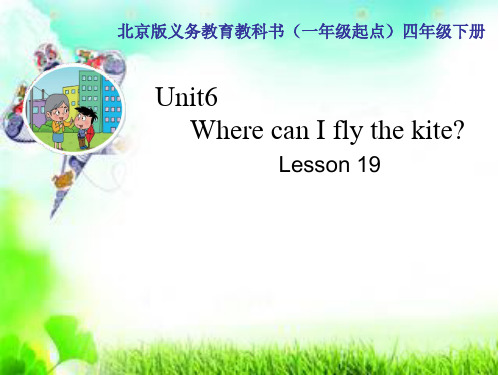
Do you see those wires? It's not safe.
I see. It's dangerous.
Where can I fly the kite,then?
You can do it at the square in front of the museum.
i-r-e fire wire
Do you see those wires? It's not safe.
I see. It's dangerous.
X √
Q3.Where can Maomao fly his kite ?
Q3.Where can Maomao fly his kite ?
插入动画
Q3.Where can Maomao fly his kite ?
He can do it at the square in front of the museum.
Where can I fly the kite,then?
You can do it at the square in front of the museum.
北京版义务教育教科书(一年级起点)四年级下册
Unit6 Where can I fly the kite?
Lesson 19
Q1.What are they talking about?
Q1.What are they talking about?
插入动画
Q1.What are they talking about?
It's not safe. It's dangerous.
Please don't here. cross the stree safe. It's dangerous.
北京课改版四下课文总结u1-u3
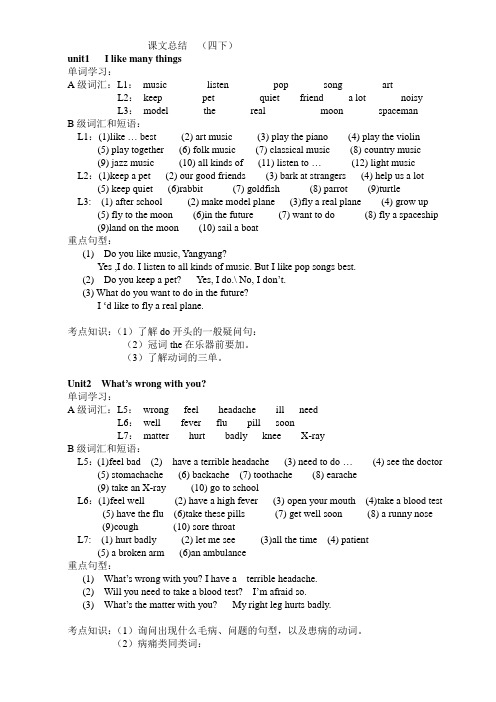
课文总结(四下)unit1 I like many things单词学习:A级词汇:L1:music listen pop song artL2:keep pet quiet friend a lot noisyL3:model the real moon spacemanB级词汇和短语:L1:(1)like … best (2) art music (3) play the piano (4) play the violin(5) play together (6) folk music (7) classical music (8) country music(9) jazz music (10) all kinds of (11) listen to …(12) light musicL2:(1)keep a pet (2) our good friends (3) bark at strangers (4) help us a lot(5) keep quiet (6)rabbit (7) goldfish (8) parrot (9)turtleL3: (1) after school (2) make model plane (3)fly a real plane (4) grow up(5) fly to the moon (6)in the future (7) want to do (8) fly a spaceship(9)land on the moon (10) sail a boat重点句型:(1) Do you like music, Yangyang?Yes ,I do. I listen to all kinds of music. But I like pop songs best.(2) Do you keep a pet? Yes, I do.\ No, I don’t.(3) What do you want to do in the future?I ‘d like to fly a real plane.考点知识:(1)了解do开头的一般疑问句:(2)冠词the在乐器前要加。
《Lesson 25课件》小学英语北京版一年级起点四年级下册4877

Who wet the floor? Why?
forgot to walk him
forget
forgot
I forgot to…
vase
What happened to the vase?
Maomao broke it.
When mom saw the vase is broken. What does mom say?
lesson25
ቤተ መጻሕፍቲ ባይዱ
What did you do to make your mum angry?
Mum looks ___an_g_r_y_. Why?
The floor is wet. The vase is broken.
Look at the floor What happened to the floor?
What happened to the vase?
What a mess! You naughty boys.
Reading piano
reading piano
1234567 i
What happened to… I'm sorry…
——What happened to …? ——I’m sorry…
Find out what happened
Story time
Pair-work:
Tips: Key words and sentences. Read dramatically.
1. Reading piano(活动设计 )
活动介绍:
reading piano
不同小组代表不同的音符,哪个音符响哪个组先进行朗读。
1 2 3 4 5 6 7 i 活动目标:
小学英语北京课标版一年级起点四年级下册课件a
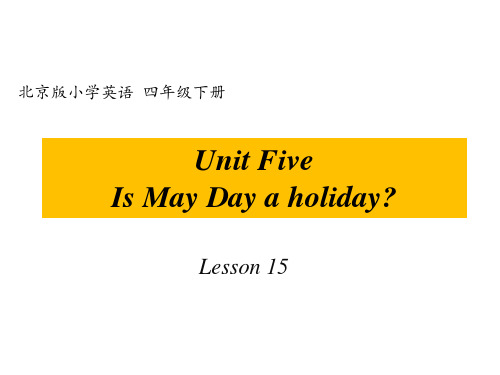
∴ We
are going to visit the Great Wall in Shanhaiguan.
She is going to visit the Great wall in Shanhaiguan.
How does Sara ask?
··Great ! So what
are you going to do on May Day?
Whose holiday is it?
·Labour Day is a holiday for the working people.
Labour Day is a holiday for the working people.
What is Guoguo going to do on May day?
New Year's Day Spring Festival
Lantern Festival
Tomb-sweeping Day
Tree-Planting day
May Day
Children's Day
Mother's Day Father's Day
Mid-autumn festival
Teachers' Day
北京版小学英语 四年级下册
Unit Five Is May Day a holiday?
Lesson 15
Spring Festival
Lantern Festival
Merry Christmas
Lantern Festival
Holidays
Spring Festival
June 1st
Christmas Day
四年下册英语北京版课文内容

Exploring the World of English throughBeijing Edition's Fourth-Grade TextbookAs I flip through the pages of my fourth-grade English textbook, I am transported to a world of adventure and discovery. The lessons are not just about grammar and vocabulary; they are about exploring new cultures, understanding different perspectives, and developing a love for learning.One of the most engaging units in the textbook is "My School Life." It introduces students to the daily routines and activities of school life, from waking up in the morning to saying goodbye at the end of the day. The vocabulary and sentences are designed to be relatable and engaging, making it easy for students to connect with the material. This unit not only helps students learn about school life but also encourages them to reflect on their own experiences and share their stories.Another fascinating unit is "Seasons and Weather." It teaches students about the different seasons and weather patterns in English, comparing them to their own experiences. Through engaging activities and discussions,students learn about the vocabulary related to weather and seasons, as well as how to describe and discuss thesetopics in English. This unit helps students develop their descriptive skills and their ability to communicate about everyday topics.The textbook also includes a unit on "Holidays and Celebrations," introducing students to different holidays and celebrations around the world. Students learn about the history and traditions behind these holidays, as well as the vocabulary and expressions related to them. This unit fosters cultural understanding and respect, encouraging students to appreciate the differences in other cultures and celebrate their own.Throughout the textbook, there are also various reading passages and stories that capture the imagination of students. These stories range from fairy tales to adventure stories, introducing students to different genres andstyles of writing. The vocabulary and sentences in these stories are designed to challenge students while still being accessible, encouraging them to read for pleasure and to develop their reading comprehension skills.In addition to the engaging content, the textbook also includes various activities and exercises that help students practice and apply what they have learned. These activities range from filling in the blanks to writing short essays, providing students with opportunities to practice their writing and speaking skills.Overall, the fourth-grade English textbook from the Beijing Edition is a rich and engaging resource for students. It not only covers the basics of grammar and vocabulary but also encourages students to explore new cultures, develop their critical thinking skills, andfoster a love for learning. As students progress through the lessons, they are not just learning about English; they are learning about the world and themselves.**通过北京版四年级英语课本探索英语世界**当我翻阅着四年级英语课本的页面时,我仿佛置身于一个充满冒险与探索的世界。
北师大版(一起)英语四年级下册全册课件
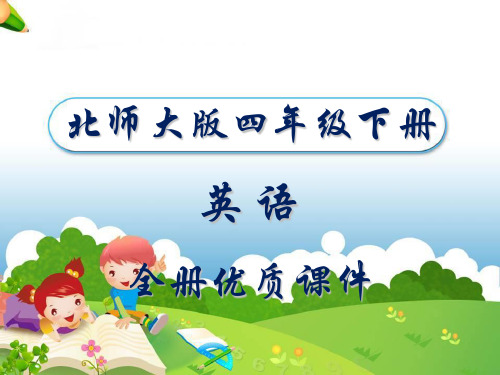
three o'clock
eight o'clock
ten o'clock
twelve o'clock
What time is it?
It's ...
What time is it?
It's seven o'clock.
It's time to go to school.
It's time to ...
8:00 4:00 9:00
watch TV
clean the classroom
have English class
Why is Mocky late?
Hurry, Mocky.It's four o'clock.It's time to visit Uncle Boocky.
What time is it,Lulu?
Talk Together
When do you get up every day?
I always get up at five in the morning.
I get up at five.
Mon Tues Wed Thur Fri Sat Sun
√√√√√√√
I always get up at five in the morning.
Homework:
Monday
8:00 10:00 12:00 3:00
Things
go to school
have English class
have lunch
play with friends
Write yours days.
北京版一年级起点小学四年级英语下册全套PPT课件

进入课题 点击进入 点击进入 点击进入 点击进入 点击进入 点击进入 点击进入 点击进入 点击进入 点击进入 点击进入 点击进入 点击进入 点击进入 点击进入 点击进入 点击进入 点击进入 点击进入 点击进入 点击进入 点击进入 点击进入 点击进入 点击进入 点击进入 点击进入 点击进入
返回目录
UNIT ONE DO YOU LIKE MUSIC?
015北京版一年级起点小学四年级英语下册PPT课件:Unit 1 What's in your room-Period 1
016北京版一年级起点小学四年级英语下册PPT课件:Unit 1 What's in your room-Period 2
017北京版一年级起点小学四年级英语下册PPT课件:Unit 1 What's in your room-Period 3
003北京版一年级起点小学四年级英语下册PPT课件:UNIT TWO WHAT'S WRONG WITH YOU-Lesson 6
004北京版一年级起点小学四年级英语下册PPT课件:UNIT TWO WHAT IS WRONG WITH YOU Lesson 8
005北京版一年级起点小学四年级英语下册PPT课件:UNIT THREE CAN YOU TELL ME THE WAY-Lesson 11
012北京版一年级起点小学四年级英语下册PPT课件:UNIT SIX WHERE CAN I FIY THE KITE Lesson 22
013北京版一年级起点小学四年级英语下册PPT课件:UNIT SEVEN WHAT HAPPENED TO THE FLOOR-Lesson 23
014北京版一年级起点小学四年级英语下册PPT课件:UNIT EIGHT REVISION Lesson 28
北京版一年级起点小学四年级英语下册全套PPT课件

Do you have a pet?
Here are some pictures of animals.
Choose one to be your pet. And talk about it with your partner.
dog
They are lovely dogs.
They are our good friends. They help us a lot.
What do you like to do after school? I like to collect eggs.
What do you like to do after school? I like to take photos for my pet.
What do you like to do after school? I like to see movies.
Presentation and practice
活动一:学习字母B的发音 1.看一看,说一说 教师引导学生观察红色字体,学生试着回答问题。 2.听一听,说一说 教师播放录音,学生认真听,然后说说听到的形同音,回答 问题。 3.读一读,想一想,讲一讲 学生一边读句子一边思考,然后教师讲解。
Presentation and practice
1.Remember these new words. 2.Read the dialogue to your parents.
Thank You
UNIT ONE DO YOU LIKE MUSIC?
Lesson 4
教学目标
知识与技能目标: 1.学生能够正确理解和朗读课文。 2.学生能够听、说、读、写本课单词。 3.学生能熟练掌握本单元词汇、句型和语音练习。 过程与方法目标: 1.通过看图观察,听录音回答问题,模仿和pair work等形式, 学生能够正确理解课文内容,朗读课文。 2.通过老师讲解、举例及学生造句等形式使学生能够运用 本单元话题。 3.通过关注语音操练单词,掌握字母B的发音。
,四年级下册第一课英语课文北京版
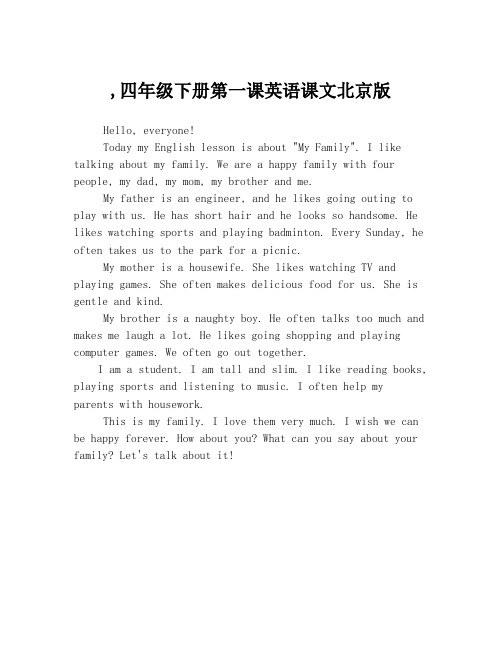
,四年级下册第一课英语课文北京版Hello, everyone!Today my English lesson is about "My Family". I like talking about my family. We are a happy family with four people, my dad, my mom, my brother and me.My father is an engineer, and he likes going outing to play with us. He has short hair and he looks so handsome. He likes watching sports and playing badminton. Every Sunday, he often takes us to the park for a picnic.My mother is a housewife. She likes watching TV and playing games. She often makes delicious food for us. She is gentle and kind.My brother is a naughty boy. He often talks too much and makes me laugh a lot. He likes going shopping and playing computer games. We often go out together.I am a student. I am tall and slim. I like reading books, playing sports and listening to music. I often help myparents with housework.This is my family. I love them very much. I wish we can be happy forever. How about you? What can you say about your family? Let's talk about it!。
- 1、下载文档前请自行甄别文档内容的完整性,平台不提供额外的编辑、内容补充、找答案等附加服务。
- 2、"仅部分预览"的文档,不可在线预览部分如存在完整性等问题,可反馈申请退款(可完整预览的文档不适用该条件!)。
- 3、如文档侵犯您的权益,请联系客服反馈,我们会尽快为您处理(人工客服工作时间:9:00-18:30)。
小学四年级英语上册-----英语课文Lesson11.Do you like music,yangyang?Yes, very much . l listen to all kinds of music. But l like of music . but l Like pop songs bestl also like pop songs but l like jazz best2.Do you like jazz Unle?No, l don’t.Do you like country music?Yes. l like country , music best.Lesson 21.Do you keep a pet Sara?No, l don’t.But l like cats they are cute and quiet. Do you keep a cat? No l don’t keep a cat l like dogs.2.sometimes they are . Why don’t you get a cat.L don’t like dogs , because they are too noisyBecause my mum doesn’t want me to.Lesson31.What do you like to d after school , mike?L like to make model planes.Ls that your model?2.What do you like to do after work , Uncle ?L like to play basketball with riends.Do you football .Sometimes l do.Lesson 51.mum, come here please.Whats wrong with you, baonao ?you don’t look very well.l feel bad l .have a headache2.let me take your temperature……………..you have a fever!Do l need to see a doctor.l’m afraidThat’s too bad. L can’t go swimmingLesson61.Doctor, he has a bad hedache and a high fever.Ok, young mam , open your mouth and “AH”Does he have the flu?L’m afraid soDon’t worry . you just hav the flu. Take some pills and you’ll get well soon.Lesson71.What’s the matter with you , young mam?Mr right leg huets, Doctor.All right, let me see.Lt hurts badly. L can’t walk.2. Does it hurt here?Yes, it hurts near the knee.L’m afraid wke an X-ray.Take it easy. Lt oesn’t hurt.Oh! ReallyLesson91.Excuse me , sir where I the new library?lt’s in that building over there.Which floor, please?The fifth floor.Thank you.2.Excuse me le the library on the left of the stairs?se.No . lt’s the third room on the right.Thank you so much.Not at all.Lesson 101. Excuse me , please . l’m looking for l find i?lt’s nearby . do you see that grey building?Yes, l doBuilding No.5 is right beseide it.2.Ah! l see building No.5 now.Yes lt’s right behind building No.4you’re so kind . thank you very much.Lesson111.Excuse me . where can l find a gas station?There is one. lt’s not far.Can you tell me the way?Sure. Please drive on, and then tjrn left at the first corner. lt’s on your right.2.l see. L should drive on and then turn left at then turn left at the first corner.Yes. the gas station is on your right you can’t miss it.Thanks a lot .you’re welcome.Lesson151.may day is coming.Ls it a holiday?’Yes. ln china , we also call it Labor day. Day .lt’s on may 1stBut in the U.S.A, labour bay is the fist Monday of September.2. labour bay is a holiday for the working people.Grea! So what are you going to do on may day?We are going to visit the Grea wall in shanhaiguan.Lesson161.children’s bay is coming .What do you do on children ’s day?We go to cinemas, parks, and museums.What do you do on children’s bay?2.do children all over the country celedrate this day.Yes, of course. We also get gifts.that’s nice. Does our school hold parties?Yes,every year on this day.Lesson171.Do you know the dragon boat festival ?No, l don’t. tell me more.lt’s a Chinese festival.2.what’ s special about this day?Ln many places people eat zongzi. They also have dragon boat races. It sounds fun.Lesson 191.Excuse me , young mam, please don’t fly your kite here.Why not?Do you see those wires? lt’s mot safe.L see. lt’s dangerous.2.where can fy the kite , then?You can do it at the square in front of the museum.All right,thank you.Lesson201.mam, can l skate here this afternoon.l’m aftaid not . lt’s dangerous. You may fall into the water. Why?lt’s getting warm. The lce is not thick enough.2. lt’s dangerous to skate on thin lcethat’s right . watch out for your safety, kate.All risht, l will.Lesson211.wow!look at the nthick crowd there.Lt’s always like this during the spring festival.lt’s not safe to push. let’s walk slowly.OK, let’s be careful.2.owch1Sorry.l stepped on your foot.that’t push in the crowd.No, l won ’tLesson231. Hi, yongyong !come inHi,l’m sorry l broke maomoa toy car l dropped,it on the floor.it’s all right, yangyang. don’t worry . l can fix it.2.lt’ maomao’s birthday gift, will he be upset?l’m sure he won’t never mind.L want to say sorry to him.Lesson241.you look sad, baobao.what’s the matter?L lost the key to our house, mum l’m sorry.Well, is it in your schoolbag?Let me check.2.uh-oh!what’s the matter now?l left my schoolbag on the olayground.Again? You should be more careful next timeLesson251.oh! what happened to the floor? lt’s wet.l’m sorry , mum lala wet it l forgot to walk him this afternoon. lt’s all right.2.what happened to the vase then?L broke it. Sorry again.What aa mess! You naughty boys.。
